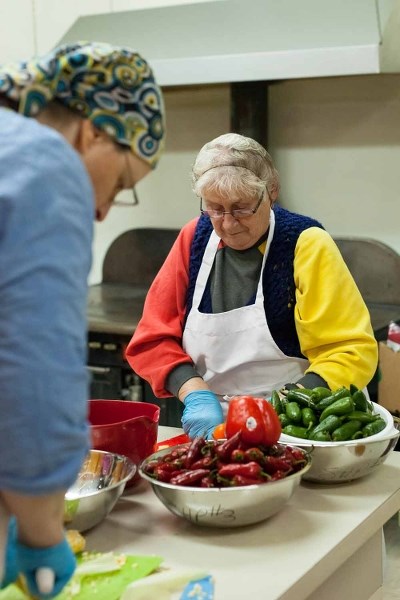On Wednesday morning, piles of green lettuce and bowls of freshly cut produce could be found in the basement kitchen of the Ukrainian Catholic Church in St. Paul. A small group was busy chopping and cleaning, preparing meals to take home and distribute in the community.
Although community kitchen-type programs have taken place in St. Paul in the past, this one is unique. The Second Harvest Project is being organized through the Gaining Momentum Society, which is a group that focuses on the “marginalized and under resourced people of our community,” according to the president of the society, Ross Stromberg.
Shirley Stromberg, Ross’ wife, was busy on Wednesday morning, delegating and directing people on the tasks that needed to be done, and on proper sanitary protocols that needed to be followed. While some volunteers were keeping track of the amount of food that had been collected and was being divvied up, other participants were in the kitchen keeping their hands busy chopping and cleaning.
The source of the fresh produce is one of the things that make the project unique. Had Shirley not initiated the Second Harvest group, the lettuce, colourful peppers, peas and potatoes gathered by the group over the last two weeks would have been thrown in the garbage.
Instead, the group is engaging people to eat healthy and pitch in with the project, while rewarding them with fresh, ready-to-cook slow cooker meals. Both Sobeys and the Co-op are getting behind the program too.
The group recognized that, despite not being sellable in a grocery store, much of the produce being discarded was still useable.
“This is not intended as a hand-out, but rather as a way to use otherwise wasted food to improve nutrition, feed families, train and equip individuals, and build community,” says Ross.
Picking up, washing, sorting, cutting chopping, packaging and freezing the produce is intensive work, and takes a regular weekly commitment of about three hours per participant. Not all food can be frozen though, so produce such as lettuce is taken home by participants to use and distribute in their communities.
For example, during the first week of the project in mid-November, a very large excess of potatoes was distributed at the Mannawanis Native Friendship Centre.
Most of the food is prepared so that it can be frozen and taken home by participants. The meals are meant to be cooked in a slow cooker, says Shirley, adding, there are already plans in place to have slow cookers donated to the participants.
The Second Harvest Project is a community effort, stresses Ross. The kitchens at the Ukrainian Catholic Church, the Bethel Family Worship Centre and the Mannwanis Native Friendship Centre are being used for the preparation of food three times a week, but the project is non-denominational, and welcomes anyone to take part.
Grants from Sobeys, and corporate donations from a number of local businesses have allowed the project to establish itself in St. Paul.
But, Second Harvest isn’t just about food, says Ross. The group is focused on creating a stronger community and drawing people together. The notion is clearly coming true, after just two weeks of the project being up and running.
“Joining the group was a good feeling,” says Diane Bellerive, who admits that she wasn’t much of a “group joiner” before. She is already a supporter of the program and believes it will benefit many local families.
Peggy Webster is being trained as a leader with the Second Harvest Project, but she is also a participant that is going to benefit from the food being prepared. Having had gastric bypass surgery, but also being low income, makes it hard for Webster to eat nutritious foods.
She says she can’t always afford fresh produce, but with the Second Harvest she has not only helped feed herself, but she has also been able to share the food with other family members, friends and neighbours.
“I’m totally grateful for it,” says Webster.



